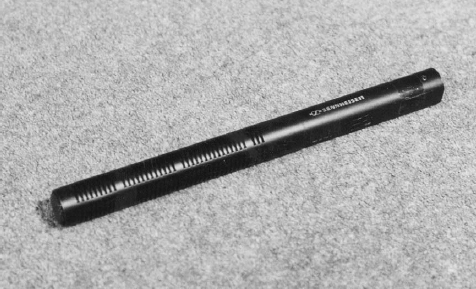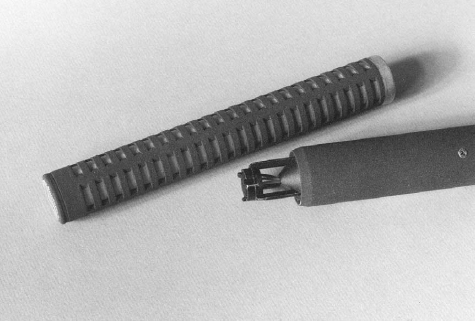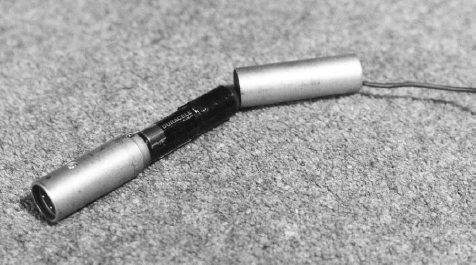8 Mics: types in common location usage
Out of the many different types of mic available, we're going to restrict our consideration to two basic pick-up characteristics, mics that ‘hear’ best in the direction in which they're pointed, and ones that hear equally in all directions. These are the ones most commonly found on location, and may be considered the workhorses of any professional kit.
Polar response
Most professional microphones are packaged together with a leaflet outlining their operational characteristics, and this may include a polar diagram (unless it's an omni-directional microphone, which rarely does these days). More often than not, the polar diagram is a graphic outline of the pick up characteristic of the microphone, and although it's displayed in two dimensions on paper, it should always be considered in three dimensions when applied to the microphone's operation. Thus, for the mics which we intend to use, those mics which hear equally in all directions – omni-directional – have a spherical polar response (Figure 8.1); and those which hear best in one direction – cardioid – have a roughly heart-shaped polar response (Figure 8.2). The latter response will be frequency dependent, and this should be indicated on its polar diagram, since gun mics, through their design limitations, tend towards an omni-directional response at low frequencies.
Frequency response
If a mic is packaged with a leaflet outlining technical characteristics, it will almost certainly indicate its frequency response. If a mic is expected to emulate the frequency range and sensitivity of normal human hearing, the graph representing the mic's response should be as close to a straight (horizontal) line as possible, between 20 Hz and 20 kHz (Figure 8.3). Nevertheless, although a straight line is to be desired, operational considerations may necessitate alternatives. For example, you would expect to find that a gun mic should have a switchable bass cut giving a decrease of between 4 and 10 dB at around 50 to 100 Hz, and this in all probability will be indicated by a lessening of response to these frequencies on the graph. However, this facility not only helps directional capability in the case of the gun mic, but also lessens handling noise, and can reduce unwanted rumbling from sources such as traffic.

Figure 8.1 Polar diagram of an omni-directional mic (Courtesy of AKG Acoustics, USA)

Figure 8.2 Polar diagram of a cardioid mic (Courtesy of AKG Acoustics, USA)
Gun mic: directional
The gun (or shot gun, or rifle) mic (Figure 8.4) is arguably the workhorse of location sound recording. It hears best along its axis, in other words, the direction in which it's pointing. Its barrel is slotted (interference tube), and this creates a phase differential for sound arriving off axis, resulting in varying amounts of cancellation (see also Section 2, Sound measurement; Phase).

Figure 8.3 A typical frequency response for a capacitor mic, showing bass cut (Courtesy of Georg Neumann GmbH, Berlin)

The longer the barrel, the more discriminating the mic is in rejecting off-axis sound, but since sounds have varying wavelengths, the discrimination is also frequency dependent, and most effective for wavelengths shorter than the barrel length, so at long wavelengths, low frequencies, the mic behaves as if it were an omni.
It's a condenser mic (see Section 37, Mics: technical information and operational summaries), and its ‘electronic ear’ (Figure 8.5) needs a voltage supplied in order to hear anything. The signal generated by the capsule must also be amplified, and the power necessary for these facilities is normally provided via the mic cable (see Phantom powering below). You may prefer to specify the option of running off a dry cell in the housing when ordering/purchasing one for location use, since not every camera/recorder provides phantom power on both mic inputs. If the mic has no other power option, you're limited to using it with equipment that can provide such power. However, be careful as it's inadvisable to leave a dry cell in situ for long periods of time if phantom powering is the norm, in case it leaks or decays, ruining a very expensive piece of equipment!
Whilst you get what you pay for, gun mics designed for broadcast use arguably provide the highest quality sound. However, you do need to take certain care when using them. This design of mic is susceptible to handling noise, and should be used with the correct mounting to function efficiently. Figure 8.6(a) and Figure 8.6(b) show the mounting cradle often associated with these mics, using rubber suspension to help minimize unwanted vibration.
Nevertheless, even using these mounts, you must exercise care when moving the mic. You may hear rumbling, should you attempt to reposition the mic too quickly, or rattling caused by the mic hitting the interior of the windshield housing the mounting. You will need to gain skill in order to successfully handle the mic on a pole/boom, although you're unlikely to face this problem whilst engaged in single person operation.

Figure 8.5 A broken gun mic, showing the interference tube and position of capsule in the housing
Care must be taken not to work the mic too close to the mouth, as condenser mics are prone to popping, the wind blast on the capsule from heavily accented ‘p’ and ‘b’ sounds (and to a lesser extent ‘d’, ‘k’ and ‘t’). It is designed for more distant work (from the sound source). They may also give trouble in damp/wet conditions (fizzing and spluttering), although windshields can help, up to a point.
The onboard camera mic is often of this type, so care must be taken if you are relying on it to provide broadcast sound, as opposed to guide track. From its position on the camera, it is prone to pick up any zoom handling and/or servo noise, so you must avoid accidentally knocking it whilst operating (more likely when the camera is hand-held).
Reporter's hand-held (stick) mic: omni-directional
The reporter's hand-held mic (Figure 8.7), is a dynamic omni-directional mic, which works on the moving-coil principle (see Section 37, Mics: technical information and operational summaries). There are omni-directional condenser mics available, but for location work, I'd advise against them.
Since no signal amplification occurs within the mic, its output is lower than that of condenser mics, and thus it's considered less sensitive. It nevertheless produces good quality sound (good frequency response), and is an extremely rugged design, standing up to rough handling. Thus it's an ideal mic for hand-holding, and many reporters prefer to have something in their hands, such as the mic, when they're doing their PTCs (the stereotype is mic in one hand, clipboard in the other).

Figure 8.6 (a) Gun mic in mounting cradle; (b) gun mic in detail

Figure 8.7 Omni-directional stick mic
It can also be used very close to the mouth, to provide a good signal-to-noise ratio, and is unlikely to suffer from popping. Partly due to its rugged construction, and since it doesn't require power, it will continue working in adverse conditions when the rest have stopped. For this reason, I would always carry one of these mics as a reliable standby.
Clip (personal) mic: omni-directional1
Works on the electret principle (see Section 37, Mics: technical information and operational summaries), which allows for a very small mic capsule (Figure 8.8) ideal for attaching (via pin or clip) to people's clothes, and lending itself to relatively easy concealment. Like the gun mic, it too needs power for signal amplification, provided via phantom power, or a dry cell in the barrel connector (Figure 8.9). The phantom power supply should override the dry cell, which, as already mentioned, should not be left in place if it's likely to remain unused for long periods of time, plus it adds that little bit of extra weight to the connector.
Nevertheless, its small size and weight makes it a favourite for single person operation, as it's so easy to carry. Its sound quality is best described as average (frequency response lacking in bass) and its quality and bass response rely on the proximity effect of clipping it close to the body (gaining some extra bass from the resonance of the chest cavity). By their design, these mics need to be placed within approximately four to eight inches from the subject's mouth. However, people rarely stay absolutely still whilst talking, so beware a turn of the head which results in severely off-mic sound.
Since they are omni-directional, in theory it doesn't matter how they are orientated, and you sometimes see them clipped upside down on contributors (Figure 8.10(a),Figure 8.10(b)). Depending on the design of the mic, it is possible that this helps protect the capsule from wind blasting, but I'd advise you to always listen to the output before finalizing your decision on the exact orientation of the mic. If the mic is in shot, it may be that anything other than ‘right way up’ could prove visually distracting. Alternatively, as far as appearance goes, depending on the style of the mic clip, upside down or even sideways may enable you to make a neater job of routing and concealing the cable.
However, should you need to use a windshield, it's far more likely to drop off an upside-down mic, and once it hits the ground it seems to completely disappear (that's another great time-waster on location, hunt the missing windshield: moral, always carry a spare). Whilst on the subject of windshields, because of their size, the use of clip mics outdoors is often restricted by windy conditions. To be effective, a Dougal-style windshield needs to be large enough to absorb the wind energy encountered. This makes it impractical for clip mics, and the windshields supplied with them tend to be overwhelmed by wind speeds in excess of 10 mph (see also Section 18, Single person operation: specific location scenarios; Wind noise).
These topics are more fully discussed in Section 11, Mics: use of clip mic for seated interview.
M/S
See Section 29, Stereo: mics and placement

Figure 8.8 Omni-directional clip mic

Figure 8.9 Dry cell in barrel housing (to power mic if no phantom power is available)

Figure 8.10 (a) Clip mic in a good operational position
Phantom powering
Condenser mics used in broadcasting are normally capable of being powered via the mic cable. This is known as phantom powering, and it is nominally 48 V. ‘Phantom’ means that this power used to activate the capsule and/or onboard amplifier should not affect the mic or the audio signal it produces in any other way. The mic usually has a ‘P’ in its model number to indicate that this is the case (see also Gun mic, and Clip mic above).

Figure 8.10 (b) Clip mic upside-down
T-power
One point to be wary of is hiring older location gun (condenser) mics that have T-powering (also called A–B powering, or modulation lead powering), normally indicated by a ‘T’ in the model number. They also obtain their power via the mic cable, but in the range 9 to 12 V. Thus, they are often supplied with their own power supply unit (dry cell/s in a small metal box with XLR input and output). If not, most portable mixers may be switched from P to T to provide the power. Do not make the mistake of plugging this mic in with P power (48 V) selected (especially vulnerable to accidental switching if connecting to the rear camcorder input), as you will almost certainly damage its capsule.
1 Directional clip mics are available, but rarely used, and unlikely to turn up in a location kit.
